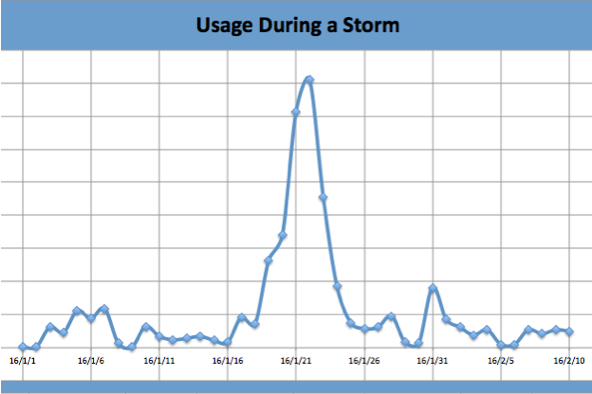When it comes to emergencies, we know to expect the unexpected. We can do our best to predict the weather but we can never know for sure just how bad a disaster will be, or how many people will be needed in the effort to respond to and recover from it. This is why every system needs to prepare for the maximum capacity of users, and be able to handle the swift spike in users at any given time.
During Winter Storm Jonas last month, our usage shot up by 900%.
Thanks to the cloud, this was no problem. Cities using EOC systems with onsite servers struggle with paying way too much to ensure that they can independently handle the maximum capacity of users with excess infrastructure that goes unused most of the time. With a cloud-based system, all participating cities are pooled in the cloud, with the expectation that only one or a few of them will peak at any given time. And during extraordinary events, when it’s likely that quite a few organizations will be utilizing the system, adding servers and increasing capacity is just a matter of flipping a few switches.
When things settle down again and demand goes down, dialling back is just as easy. Waste not, want not.
Consider the following hypothetical example:
10 cities utilize the system. Each of these cities has a potential peak of 1000 users logged in at the same time during a crisis. On an average day, though, only 100 of their users are logged in.
- A server to handle 1000 simultaneous logins costs $10,000. This means that if each city were to have its own server, it would need to spend $10,000 for the server that can handle its potential peak usage. That’s $100,000 in total for all 10 cities.
- Now, if all 10 cities’ users could be pooled in a cloud-based system, and assuming an example scenario in which 1 of them sees peak usage, that would mean 1 city X 1,000 users, plus 9 other cities X 100 users each, or 1,900 – let’s round up to 2,000 – total users on the system simultaneously. This would require 2 servers to handle the load, which cost $20,000 together.
- Going further, if the cost of the pooled servers were to be distributed among the 10 cities, the cost is $2,000 per city. That’s $8,000 less for each city if they were to purchase their own servers.
- As mentioned, the ability to add capacity is an essential part of the system, and here the math is straightforward. The only time the cost of the cloud-based system would reach the same level of individually purchased servers would be an almost unimaginably widespread event, and even then the numbers make sense, because over time the cost will be reflective average usage.
- At Veoci, paying only for what is needed, when it is needed, makes sense to us and our users – system management and maintenance is simplified, performance and capacity planning are robust, and costs are kept down.








